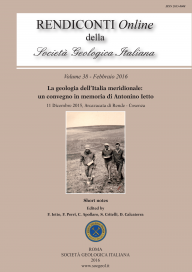
Evidences of fossil landslides from the Lower Pleistocene on the northwestern margin of the Mesima basin (southern Calabria, Italy)
Fabio Ietto (a) & Maria Pia Bernasconi (a)
(a) Dipartimento di Biologia, Ecologia e Scienze della Terra, Università della Calabria, 87036 Arcavacata di Rende, Cosenza, Italy. Corresponding author e-mail: fabio.ietto@unical.it
Volume: 38/2016
Pages: 65-68
Abstract
The present work aims to study the Pleistocene landslides located on the eastern side of the Vibo Valentia hill (southern Calabria, Italy). The Vibo Valentia hill, situated on the Tyrrhenian side of the Calabria-Peloritani Arc, is constituted by basement rocks made up of granulitic gneiss crossed by a network of marine sediment veins. Recent excavations for a new road have made possible seeing some indication of old landslide morphologies. The landslides are fully integrated into the existing topography and little indications of the former landslide morphologies remain. The principal evidences of the landslide morphologies are represented by presence of breccias and heterometric conglomerates made up of gneiss embedded in a fossiliferous carbonatic matrix. Furthermore, failure surfaces are marked by a thin calcareous micritic layer enriched in pelagic foraminifera. The fossil assemblage allowed to date the landslides at the Lower Pleistocene and classify them as fossil landslides. The geomorphologic and sedimentary context suggested that the Vibo Valentia hill was a coastal cliff developed in an active fault zone during the Lower Pleistocene and characterized by a rapid uplift. This geological context created favorable conditions for the trigger of landslides along the cliff made up of gneissic rocks.
Keywords
Get Full Text